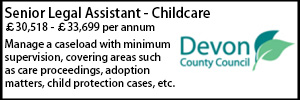Social care funding: rapid response note
- Details
Fenella Morris QC, Sian Davies and Arianna Kelly analyse the Government's proposals for social care funding reform and look at the key issues for local authorities.
While a White Paper and statutory instruments remain to seen, the ‘Build Back Better: Our plan for health and social care’ Command Paper has set the parameters for social care funding reform. The headline announcements have related to the cap on care costs, and the Command Paper sets out a number of reforms likely to impact on the charges people will face for care and the funding available in the care system. The Command Paper confirms that there will be an extra £5.4 billion for funding for adult social care, but states that it expects ‘demographic and unit cost pressures will be met through Council Tax, social care precept, and long-term efficiencies… the overall level of Local Government funding, including Council Tax and social care precept, will be determined in the round at the Spending Review in the normal way.’
The Command Paper sets out four primary aims of social care reform:
a. introduce a cap on personal care costs;
b. provide financial assistance to those without substantial assets;
c. deliver wider support for the social care system, particularly our brilliant social care staff; and
d. improve the integration of health and social care systems.
Cap on care costs
The Command Paper confirms that the cap on care costs will follow the statutory framework already set within the Care Act 2014. In overview, the Care Act cap on care costs operates as follows:
- Under s.14 Care Act 2014, the power of a local authority to make any charge for a person’s care is limited by the cap on care costs set out in s.15 of the Act.
- Under s.15, a local authority may not make any charges for meeting the person’s eligible needs under s.18 ‘if the total of the costs accrued in meeting the adult’s eligible needs after the commencement of this section exceeds the cap on care costs’.
- To determine the extent of the person’s eligible needs and how they are to be met, the local authority must conduct a needs assessment under s.9 Care Act, determine eligibility and the duty to meet needs under ss.13 and 18 and prepare a care and support plan under s.25. The s.18 duty to meet eligible needs does not apply to those of the person’s needs which are being met by a carer per s.18(7).
- To determine the cost of meeting those eligible needs, the local authority must prepare either a personal budget under s.26 Care Act if the local authority is meeting the person’s needs, or an independent personal budget under s.28 Care Act if arrangements are being made other than by a local authority. Notably, the independent personal budget does not measure what the person is actually spending, but ‘what the cost would be to the local authority…of meeting the adult’s eligible needs for care and support’.
- Funds spent on meeting needs which do not fall within the eligibility criteria would not count towards the cap. The putative cost to the local authority of meeting eligible needs which are being met by a carer (which, within the context of the Care Act, references an informal, unpaid carer) would not count towards the cap per s.15(3).
- The local authority must maintain a ‘care account’ under s.29 Care Act to keep an up-to-date record of the adult’s accrued costs, and inform the person once those costs exceed the cap on care costs. The record must be maintained either for 99 years from the day on which it was last updated, or until the adult’s death.
- Under s.16 Care Act, the cap on care costs is to be annually adjusted in line with average annual earnings in England ‘in such manner as the Secretary of State thinks fit’ per s.16(3). The accrued costs in a person’s care account would also be annually varied by the same percentage as the adjustment to the cap; local authorities would be responsible for updating the care account accordingly.
The Care Act is clear that in the personal budget or independent personal budget, there must be a separation of the amounts attributable to the adult’s daily living costs, spending on which does not count towards the cap, even if spent in a care setting, and the costs of care, which do contribute to the care account. Daily living costs would also remain chargeable after a person exceeded the cap on care costs per s.15(7). This is an issue which would primarily require specific consideration for those in residential care settings in which there is a unity of provision as between accommodation and care. Where the person is in their own home or in an accommodation in which they have a tenancy, the separation of costs is likely to be clearer.
The Command Paper provides several new measures:
- The cap is to come into effect from October 2023. Per the Care Act framework in s.15, only costs accrued after this date would be counted towards the cap; there is no current proposal to retrospectively calculate the out-of-pocket costs a person has spent on care.
- The cap on care costs is to be set at £86,000. S.16 Care Act already provides for annual adjustment of the cap, and the Command Paper is silent on whether this would be altered.
- The Command Paper repeatedly states that the cap on care costs will be towards costs spent on ‘personal care’. It is not clear from the Command Paper whether ‘personal care’ is being used in the legal sense per the Health and Social Care Act 2008 and the Health and Social Care Act 2008 (Regulated Activities) Regulations 2014. [1] This is a distinction from the existing Care Act framework, which measured the cap against costs spent on ‘eligible needs,’ and did not limit it to personal care only.
- The Command Paper appears to state that income charges would also end once the cap on care costs had been met. This is in line with s.14 Care Act, which creates the statutory authority for income charges, and states that no charge is to be made once the cap has been met.
- The Command Paper appears to reaffirm the approach under the Care Act that the cap is in respect of needs the local authority would be obliged to meet only, and funds spent by the person as a matter of choice rather than necessity would not count towards the cap: ‘People may choose to “top up” their care costs by paying the difference towards a more expensive service, but this will not count towards the cap.’
We would note that when the cap on care costs was under consideration in 2015, there were multiple outstanding issues requiring resolution. Many of these remain unresolved, including:
- Whether the cap is now only for funds spent on ‘personal care’ or all eligible care needs;
- Is the cap only measuring capital contributions, or would it also include the amount a person has spent in income on meeting care needs? This is likely to have a considerable effect on people whose care needs start at a younger age, and may be paying a significant portion of their income throughout their lives.
- S.15(4) Care Act created provision for regulations to be made allowing the cap to be set at £0 for ‘persons of a specified description’ or to ‘specify different amounts for persons of different age groups.’ We would note that in 2015, consideration had been given to whether people whose care needs started at a young age should be given a lower or nil cap; no decision on point was taken either in 2015 nor in the Command Paper. We would note the Dilnot Commission recommendation for a tiered approach to the cap, with anyone turning 18 with eligible care needs (or developing eligible care needs under the age of 40) having a nil cap.
- The amount of daily living costs for those in residential care also requires further specification. In 2015, consideration was given to attributing a flat rate of approximately £200/week for daily living costs. It was noted by many in northern England that such a figure would constitute a far larger percentage of care home costs than they would in the south and prevent significant progress towards the cap for long-term self-funders in certain regions of the country.
We would also note that measuring progress towards the cap is dependent on the person having requested the local authority provide an assessment, care plan and personal budget. The introduction of the cap, and the steps required to measure progress towards it, would appear likely to dramatically increase the number of self-funders seeking assessment and care planning from the local authority, and potentially creating disputes over the putative cost to the local authority of meeting the person’s needs.
The Dilnot Commission emphasised that a key reason for the cap on care costs was to promote a sustainable and more affordable market for long-term care insurance. Insurers may also have an interest in challenging local authority decisions on independent personal budgets for people with high care costs to speed progress towards the cap.
Means-tested support for care
The Care and Support (Charging and Assessment of Resources) Regulations 2014 sets the current upper and lower capital limits, which currently have the following effects:
- Individuals with more than £23,250 in assessable capital are responsible for paying the full cost of their care.
- Individuals with less than £14,250 in assessable capital are not required to make any contribution from their capital for the cost of their care and support (though would still pay any relevant income charge).
- Individuals with assessable capital between £14,250 and £23,250 are required to pay a tariff income from capital, in the amount of £1 ‘for each complete £250 in excess of £14,250 but not exceeding £23,250’ per week, along with any relevant income charge.
The Command Paper sets out that there will be new upper and lower capital limits of, respectively, £100,000 and £20,000. The Command Paper confirms that the current rules for when a person’s main or only home would be disregarded for the purposes of determining assessable capital would remain in effect. Under the proposed new regime:
- Individuals with more than £100,000 in assessable capital are responsible for paying the full cost of their care.
- Individuals with less than £20,000 in assessable capital are not required to make any contribution from their capital for the cost of their care and support (though would still pay any relevant income charge, unless they have already exceeded the cap on care costs).
- Individuals with assessable capital between £100,000 and £20,000 would be required to pay a tariff income which appears broadly aligned with the current rules: a person would be required to pay ‘not more than’ 20% of ‘chargeable’ capital annually. It is not clear whether ‘chargeable’ capital would include the last £20,000 of a person’s capital below the lower capital limit. Again, the person would continue to be assessed for any relevant charge on income, unless they have already exceeded the cap on care costs.
Duties to self-funders
The Command paper states:
We will also tackle persistent unfairness in the social care system. Under the current system, people who fund their own care often pay more than people who are funded through their Local Authority for equivalent care. For the first time, using legislation included in the 2014 Care Act, we will ensure that self-funders are able to ask their Local Authority to arrange their care for them so that they can find better value care.
We would note that many, though not all, self-funders may already require the local authority to arrange their care under s.18 Care Act. All self-funders outside of care homes may ask a local authority to arrange their care, as well any person who lacks capacity to arrange care and support and has no person authorised under the Mental Capacity Act ‘or otherwise in a position to do so’; in either case, a local authority may make an arrangement fee for providing the person’s care, in addition to charging the person for the cost of the care.
The s.18 duties in respect of self-funders were limited by s.3 of Care Act 2014 (Commencement No 4) Order 2015 (SI 2015/993), which states the s.18 duty did not come into effect in 2015 ‘insofar as it imposes any duty on a local authority to meet an adult's needs for care and support by the provision of accommodation in a care home’ for a person with capacity. A self-funder who either has capacity to arrange his or her own care, or has a person authorised do so, may only have a need for accommodation in a care home met by the local authority pursuant to its power to do so under s.19 Care Act.
S.14 Care Act 2014 sets out the power of a local authority to make charges for meeting needs for care and support. S.14(4) bars a local authority from making a charge greater than the cost of meeting a person’s needs. Regulation 12 of Care and Support (Charging and Assessment of Resources) Regulations provides that a local authority ‘is not permitted to pay towards the cost of provision of accommodation in a care home’ for a person over the upper capital limit.
However, self-funders are not currently entitled to insist on paying the same rates for their care as the local authority would pay itself, and typically do not do so. Local authorities often work to block contracts or have set rates with approved providers which are lower than those offered to self-funders. Case law has highlighted the disparities of these rates, and that some local authority funding models rely on the higher rates paid to care providers by the NHS, self-funders and people whose families pay top-ups for their care to support a sustainable market. Torbay Council v Torbay Quality Care Forum Ltd [2017] EWCA Civ 1605
Income charges
The Command Paper states that from April 2022, the freeze (which has been in effect since 2016) on both the Personal Expenses Allowance for those in residential care and the Minimum Income Guarantee for those in non-residential care will end. The Command Paper states that ‘from April 2022 they will both rise in line with inflation.’
Deferred Payment Agreements
The Command Paper confirms that existing provisions for Deferred Payment Agreements will remain, and DHSC ‘will work with partners to review the existing scheme in order to provide more flexibility for people to defer their care payments.’ Further details on how this may occur are not yet provided.
Analysis
In considering the effects and potential legal issues which may arise due to changes to how social care is funded, the ‘market-shaping duty’ (s.5 Care Act) will be a very important factor. The market-shaping duty is one of the core duties under the Act, and s.5(1) obliges a local authority to promote the effective and effective operation of a market in in services for meeting care and support needs. The duty is interwoven with other duties under the Act under s.5(3)-(4):
(3) In having regard to the matters mentioned in subsection (2)(b), a local authority must also have regard to the need to ensure that sufficient services are available for meeting the needs for care and support of adults in its area and the needs for support of carers in its area.
(4) In arranging for the provision by persons other than it of services for meeting care and support needs, a local authority must have regard to the importance of promoting the well-being of adults in its area with needs for care and support and the well-being of carers in its area.
The Care and Support Statutory Guidance also emphasises the role of the local authority as a commissioner of care in promoting a health market:
4.1 High-quality, personalised care and support can only be achieved where there is a vibrant, responsive market of service providers. The role of the local authority is critical to achieving this, both through the actions it takes to commission services directly to meet needs and the broader understanding of and interactions it undertakes with, the wider market, for the benefit of all local people and communities…
4.52 Commissioning and market shaping should be fundamental means for local authorities to facilitate effective services in their area and it is important that authorities develop evidence-based local strategies for how they exercise these functions, and align these with wider corporate planning. Local authorities should have in place published strategies that include plans that show how their legislative duties, corporate plans, analysis of local needs and requirements (integrated with the Joint Strategic Needs Assessment and Joint Health and Wellbeing Strategy), thorough engagement with people, carers and families, market and supply analysis, market structuring and interventions, resource allocations and procurement and contract management activities translate (now and in future) into appropriate high quality services that deliver identified outcomes for the people in their area and address any identified gaps.
We would note the considerable anecdotal evidence raising concerns about the state of the care market, including closures of care homes, and struggles to recruit care staff in many parts of the country. The proposals on funding suggest that there may be less money coming into the system from self-funders, through a combination of:
- Self-funders potentially be able to access local authority contracted rates;
- Self-funders with capital up to £100,000 coming within the Care Act framework regardless of where they are receiving care;
- The cap on care costs
This comes at a time when providers may be facing other impacts, due to the combined effects of Brexit, vaccine requirements for carers and costs of providers (including the additional National Insurance costs to fund social care reforms).
Local authorities will need to factor these impacts into the Joint Strategic Needs Assessments and market position statements. They will need to be alive to the risks of provider failure, and to ensure that plans are in place to meet needs in the event provider failure to is occur. We would note that there may be possible challenges to local authorities where market shaping duties are not considered and/ or rates do not allow for sustainable model; previous challenges (including in the Torbay case above and R(Care England) v Essex County Council [2017] EWHC 3035 (Admin)) were unsuccessful largely due to the local authorities being able to demonstrate that providers were not failing, and CQC rating remained strong. In local authorities were care providers are struggling, a market-shaping duty challenge may gain more traction.
Fenella Morris QC, Sian Davies and Arianna Kelly are barristers at 39 Essex Chambers.
Watch Fenella, Sian and Arianna's webinar on the Government's proposals.
[1] Defined as:
(a) physical assistance given to a person in connection with—
(i) eating or drinking (including the maintenance of established parenteral nutrition),
(ii) toileting (including in relation to the process of menstruation),
(iii) washing or bathing,
(iv) dressing,
(v) oral care, or
(vi) the care of skin, hair and nails (with the exception of nail care provided by a person registered with the Health and Care Professions Council as a chiropodist or podiatrist pursuant to article 5 of the 2001 Order), or
(b) the prompting, together with supervision, of a person, in relation to the performance of any of the activities listed in paragraph (a), where that person is unable to make a decision for themselves in relation to performing such an activity without such prompting and supervision;


















































